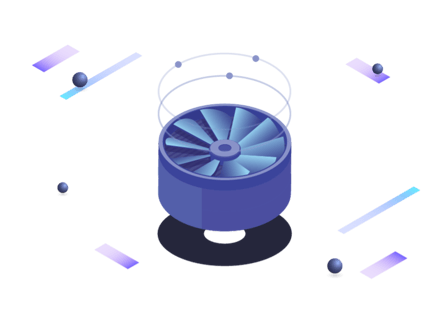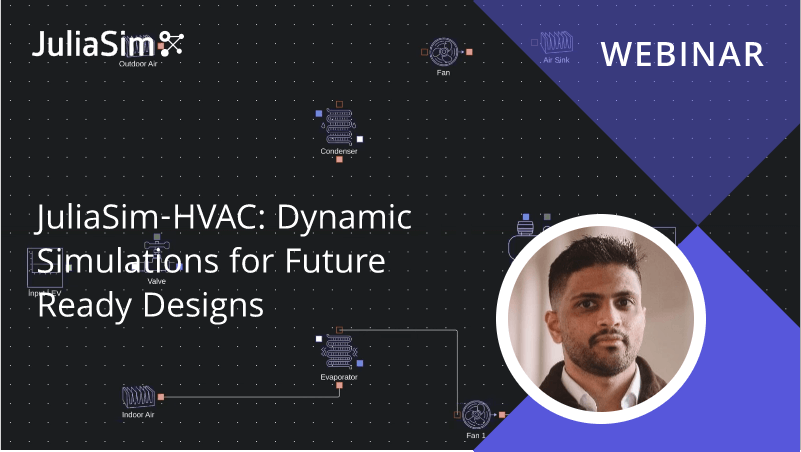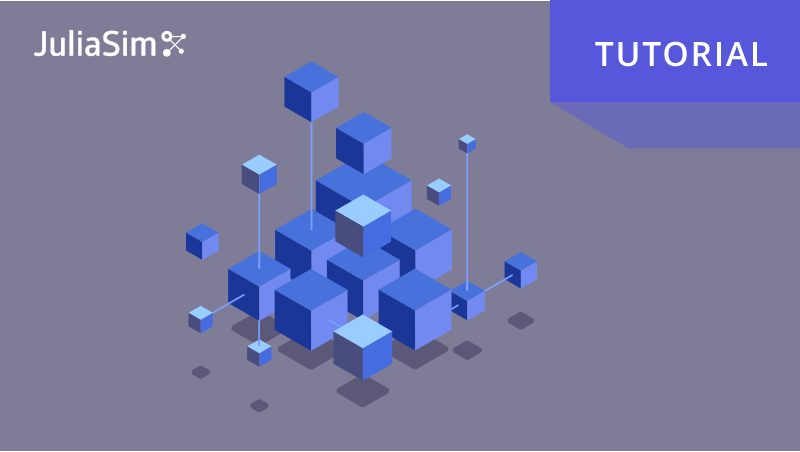
Revolutionizing HVAC System Design and Optimization
Dyad HVAC takes a fresh approach to tackle the complexities of HVAC (Heating, Ventilation, and Air Conditioning) system modeling and simulation. It offers a comprehensive suite of tools to model and simulate complex thermofluid systems. The Dyad HVAC library of pre-built components and refrigerant models connects to advanced solvers that are customized to system behavior and are composable with the Dyad Scientific Machine Learning (SciML) ecosystem.

Simplifying Complex HVAC
Design and Modeling
Unlike current design workflows that use disparate tools for each step such as modeling and simulation, calibration, design optimization, control design, and machine learning, the Dyad (Formerly JuliaSim) platform unifies all the stages in a single environment.
CHALLENGES
IN HVAC & R DESIGN AND MODELING

Complex HVAC & R systems with multiple phases, fluid dynamics, thermodynamics, and control interactions

Siloed workflows
with separate tools for each phase – modeling, simulation, calibration, and design

Computationally expensive
and resource-intensive processes
OUR SOLUTION
Physics-based models
with the latest in machine
learning & control systems

Streamlined Workflows
Design within a single environment, reducing the need for disparate tools and improving efficiency.

Pre-built Components
Industry-grade ready-made components. Validated mechanistic and data-driven models for a variety of thermal-fluid systems. Accurate spline-based refrigerant models 1000x faster than Equation-Of-State based models.

Enhanced Diagnostic Capabilities
Dyad’s ModelingToolkit, integrated with SciML tools, provides exceptional diagnostic capabilities.
Enhanced Performance
Achieve up to a 60x-570x speed-up over alternative tools by combining advanced numerical techniques with scientific machine learning.

Improved Accuracy
Utilize high-fidelity models and advanced solvers to capture the complexities of HVAC systems with greater precision, reliably.
Transforming Thermofluid System Design,
Optimization, and Control

Pre-built Components
Access a robust library of ready-to-use HVAC components, including Tube-Fin Heat Exchangers, Compressors, Valves, Fans, Conditioned Spaces, and Pipes. These components are configurable to accurately represent real-world systems and facilitate rapid prototyping through an intuitive drag-and-drop GUI.
Industry-Grade Thermodynamic Property Models
Utilize spline-based thermodynamic property models for various refrigerants, including R32, R1234YF, R290, R152a, R134a, R410A, and R717, as well as models for Dry Air and Moist Air. These advanced models enhance the accuracy of simulations by addressing the multi-phase behavior and discontinuous properties of refrigerants.
Machine Learning Integration
Integrate with data using Dyad’s AI tooling for automated model calibration, surrogate modeling, and model discovery. Integrate with Dyad Model Optimizer for automated model calibration unleashing the power of automatic differentiation of the simulator. Leverage Dyad Digital Echo for model acceleration and elimination of irrelevant dynamics using neural surrogates.
Advanced Solvers
Leverage advanced solvers capable of handling stiff, nonlinear, and discontinuous dynamics. Dyad HVAC offers a wide range of methods, including GPU parallelism, to ensure high performance and robustness in solving complex systems.
Content Design and Analysis
Connect with Dyad Control for advanced control design. Perform PID, Linear, and Nonlinear Model Predictive Control (MPC) analyses, linearize around operating points, and generate C code for deploying tuned models to embedded systems.
Multi-Domain Simulation
Integrate with other domain-specific models such as Dyad Batteries, Fluids, and Media. Import and export FMUs (Functional Mock-up Units) using FMI v2 and v3 standards for model exchange and co-simulation with other simulation tools.
Specialized DAE Initialization
Handle large-scale models with specialized Differential-Algebraic Equation (DAE) initialization routines. These robust solvers address the challenges of stiff, nonlinear, and discontinuous dynamics effectively.
LEARN MORE ABOUT DYAD HVAC AND HOW IT IS BEING USED
Improved HVAC Diagnostics
Enhancing HVAC Diagnostics with Scientific Machine Learning and First Principles modeling

%20(1).jpg)

